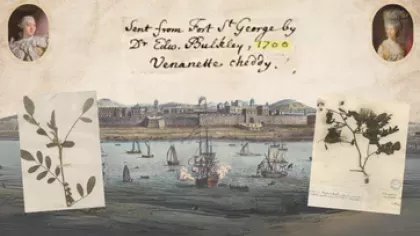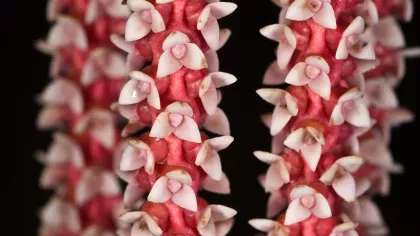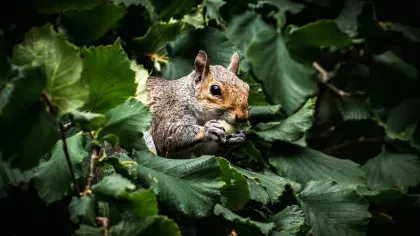Priority conifer seed collecting from the Pacific Slope
Kew scientist Michael Way reports on an expedition to the western United States to collect seed from priority conifers for Kew’s Global Tree Seed Bank Project.

The Pacific Slope spanning Washington, Oregon and California is one of the best locations in the world to explore conifers, from the majestic coastal redwoods to the ancient and stunted bristlecone pines.
Our Global Tree Seed Bank Project, supported by the Garfield Weston Foundation, is targeting useful and threatened trees around the world; we identified some shared priorities with the US Forest Service and cooperating arboreta in the UK. From the 65 conifers recognised as native to this region, three groups stood out as priority for a joint US-UK seed collecting expedition in 2016: Abies (firs), Picea (spruces) and Cupressus (cypresses).
The extensive federal and state landholdings in the western US protect tree populations from most changes of land use, and provide opportunities for species to adapt and migrate.
But increasing threats from wildfire, tree pests and climate change have demonstrated that in situ conservation is not sufficient on its own to safeguard key populations of plant species.
Storing large collections of high quality seed at the National Centre for Genetic Resources Preservation in the US, with duplicates at Kew’s Millennium Seed Bank will provide multiple options for research, horticulture and translocation for many decades ahead.
One target of the expedition was the graceful Brewer spruce (Picea breweriana) which survives in six places within the relictual Arcto-Tertiary forests of the Pacific Slope.
It has already been eliminated from several areas prone to fire, and the observed decline in this species has contributed to a conservation assessment by IUCN as ‘Vulnerable’.
Ledig et al. (2012) predicted that current habitats will become significantly warmer and drier in the coming decades, envisaging a managed translocation of this species to suitable future habitat in British Columbia, Canada.

News from the Pacific Slope
Andrew Bower, my counterpart at US Forest Service (FS), provided encouraging news in August from a scoping trip including some sample ‘cut-tests’ which are used to assess the quantity and quality of seed in a cone.
The seed crop was impressive, probably a mast year for our target species. It is thought that heavy and synchronous seed dispersal may overwhelm seed predators and enable a new generation of seedlings to germinate and establish.
The detailed cut-test data helped us to plan for a large expedition team to assemble for two weeks in September, and to submit detailed collecting permit applications to the Forest Service managers in the region.


Putting together the expedition team
Clearly we would need skilled arborists able to climb our varied trees, secure themselves in the crown, and to pick an agreed number (typically 50) of mature cones into sacks.
Andrew was able to secure skilled climbers from several FS units, including three of the renowned parachuting firefighters known as ‘smoke jumpers’ who bring impressive field skills.
From the UK, support was offered from the Forestry Commission’s Bedgebury Pinetum, University of Oxford Harcourt Arboretum and Kew’s Wakehurst site, home to the Millennium Seed Bank. Andrew and I coordinated the collecting and acted as ground support for the climbers, keeping an eye out for hazards and assisting in an emergency situation.


Timing is everything: locating cones before seed is dispersed
As they ripen, the seed-bearing cones of our target Abies will dry, open, and rapidly fall apart to liberate small winged seeds. Climbers need to locate and harvest cones before this happens – on some sites the cones crumbled in their hands at the slightest touch.
To create the dried plant (herbarium) specimens of Abies, we held the cones together by tying them tightly with string. During the trip we placed the closed cone collections in massive hessian sacks where the cones could dry and release seeds, and we checked the collections every evening.

The target cypress trees are unusual in that seeds accumulate in the canopy as cones are produced each year, and are only dispersed when conditions are right.
This is known as serotiny: an ecological adaptation where seeds are only released in response to an environmental trigger, such as after a forest fire.
Serotiny presents a challenge to obtain seed which is fully mature, ready for dispersal, and yet has not experienced significant ageing.
Results of the expedition
Overall we made twelve large targeted tree seed collections, together with several smaller collections of shrubs such as Arctostaphylos and Ribes species which will also be seed-banked.
Each collection has complete field data and a set of herbarium specimens for partners. I am particularly pleased that we have sampled conifers from several relict populations that may hold unique genetic diversity for future adaptation.
For example, Picea breweriana seed is now held from both Baldy and Iron Mountains, two of the high elevation outlier populations reported in Ledig et al. (2012). This could provide valuable material for management and conservation of this species, and will make a good contribution to Kew’s Global Tree Seed Bank.
Acknowledgements
Support was provided by Forestry Commission England. Funding was provided by the Friends of Bedgebury Pinetum and the Garfield Weston Foundation. The expedition team also comprised George Morris (RBG Kew); Luke Rowland (University of Oxford Harcourt Arboretum); and Andrew Bower; Jensen Chase; Phillip Chi; Drew Peterson; Mathew Mendonca; Jace Lewis; & Joe Madden (US Forest Service).
References
Ledig, F.T., Rehfeldt, G.E. & Jaquish, B. (2012). Projections of suitable habitat under climate change scenarios: Implications for trans-boundary assisted colonization. American Journal of Botany 99 (7): 1217–1230.






